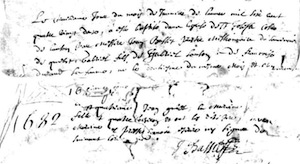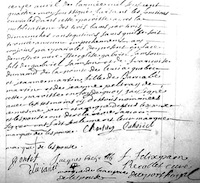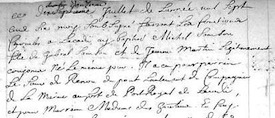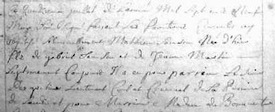Cape Breton, Nova Scotia
The Acadian Branch

History of the Acadian Samsons
According to the civil archives at Cap-St-Ignace, Quebec, Gabriel Sanson, the son of Gabriel Sanson and Francoise Durand, born January 12, 1682, was baptized at Lauzon, on January 16, 1682, in the presence of Jean Guiet, by Jean Basset, missionary priest from the seminary of Quebec. His baptismal record reads:
 On the sixteenth day of the month of January, in the year 1682, was baptized in the church of St. Joseph of Lauzon, Gabriel, son of Gabriel Sanson and Francoise Durand, his wife, born on the twelfth of the same month, in the presence of Jean Guiet, by Jean Basset, missionary priest.
On the sixteenth day of the month of January, in the year 1682, was baptized in the church of St. Joseph of Lauzon, Gabriel, son of Gabriel Sanson and Francoise Durand, his wife, born on the twelfth of the same month, in the presence of Jean Guiet, by Jean Basset, missionary priest.Gabriel was the couple’s seventh child and fourth son, and was only 8 years old when his father died. He grew up on the farm at the Point of Levis, and may have trained in carpentry and shipbuilding, as he was described in later census documents as a carpenter, builder, and navigator. Gabriel left Quebec to work in Port Royal, Acadia, and although he may have intended to stay temporarily, he never did return.
In 1701, Port Royal was a small community, and numbered fewer than 500 inhabitants. According to the author Rameau de Saint-Pere, the village consisted of a rough fort, a church, and a few houses. Lands were divided, as they were in France and Quebec, into long rectangular parcels perpendicular to the shore of the river. Settlers built their homes on the uplands, while cultivating the lowlands with wheat and hay, and using the wooded hills for firewood and building materials. Instead of clearing the forests, they built dykes on the low-lying lands adjacent to the Bay of Fundy. The reclamation of the salt-water marshes through the use of dyke building became a distinct characteristic of Acadian farming. During his visit to Port Royal in 1699, Sieur de Diereville of Normandy wrote: “The ebb and flow of the Sea cannot easily be stopped, but the Acadians succeed in doing so by means of great Dykes, called Aboiteau.”
Twenty two year old Gabriel Samson married Jeanne Martin, the young widow of Louis Chesnay dit La Garenne, and mother of two children, Marie-Josephe and Jean-Baptiste Chesnay. Jeanne was the daughter of Barnabe Martin and Jeanne Pelletret. She was born in Port Royal about 1676, and first married there about 1697 to Chesnay, a young settler from Quebec. Six years his senior, the widow Chesnay married Gabriel at the church of St. Jean-Baptiste of Port Royal, on April 7, 1704. Their marriage record read in part (RG1, Vol 26, p. 271):
 “On the 7th of April in the year 1704, I, the undersigned, performing the civil functions in this parish, and following the publication of three bans for three consecutive Sundays without any impediments, have married in this church, Gabriel Samson, son of Gabriel Samson and Francoise Durand, of the Pointe of Levis, Quebec; and Jeanne Martin, daughter of Barnabe Martin and Jeanne Peltray of this parish. I have signed with the witnesses below, and the groom and bride have made their mark, Felix Pain, Recollet priest.” Witnesses were Chartier, Cahouet, Pontif, Jacques Cochu, Elie Gentil (Jeanne’s brother-in-law), and Jacques Le Vanier, (Jeanne’s stepfather).
“On the 7th of April in the year 1704, I, the undersigned, performing the civil functions in this parish, and following the publication of three bans for three consecutive Sundays without any impediments, have married in this church, Gabriel Samson, son of Gabriel Samson and Francoise Durand, of the Pointe of Levis, Quebec; and Jeanne Martin, daughter of Barnabe Martin and Jeanne Peltray of this parish. I have signed with the witnesses below, and the groom and bride have made their mark, Felix Pain, Recollet priest.” Witnesses were Chartier, Cahouet, Pontif, Jacques Cochu, Elie Gentil (Jeanne’s brother-in-law), and Jacques Le Vanier, (Jeanne’s stepfather). Gabriel and Jeanne enjoyed a brief period of happiness before another attack from New England by Major Church, on July 2, 1704. Church killed and captured close to 100 Acadians at Port Royal, and burned about 26 houses. Gabriel and Jeanne were certainly among those captured, since their daughter Madeleine was born in Boston on January 9, 1705. The family was finally returned to Port Royal more than a year later, where Madeleine was baptized on January 27, 1706, and their son Michel was born a few months later in July. His baptism in the church records of St. Jean-Baptiste of Port Royal shows Michel Samson, born July 12, 1706, baptized the same day, the son of Gabriel Samson and Jeanne Martin.
 Gabriel Samson was enumerated in the 1707 census of Port Royal, with his wife, 2 sons under 14 years of age, 2 daughters under 12 years of age (which included his step-children), 4 horned animals, 5 pigs, a half arpent of land, and 1 gun. In 1709, the couple had a second son, Mathieu, born on August 14, 1709, and baptized at Port Royal on the following day. A copy of his baptismal record is shown below. The Samson family was included in the Port Royal census of 1710 and 1714, where Gabriel had 3 sons and 2 daughters.
Gabriel Samson was enumerated in the 1707 census of Port Royal, with his wife, 2 sons under 14 years of age, 2 daughters under 12 years of age (which included his step-children), 4 horned animals, 5 pigs, a half arpent of land, and 1 gun. In 1709, the couple had a second son, Mathieu, born on August 14, 1709, and baptized at Port Royal on the following day. A copy of his baptismal record is shown below. The Samson family was included in the Port Royal census of 1710 and 1714, where Gabriel had 3 sons and 2 daughters. Gabriel and Jeanne had a family of 11 children, 7 surviving to adulthood. He worked as an engineer at Port Royal, but left the capital when the British overtook the Port for the last time. In order to avoid taking the oath of allegiance to the British Crown, Gabriel and his family emigrated to Port Toulouse (present day St. Peter’s, Cape Breton), on Ile Royale around 1720-21, where he built and navigated coasting vessels. In the census of 1722, at Port Toulouse, Gabriel Samson is listed, an Acadian, with 10 persons. In the 1724 census of Port Toulouse, he is enumerated, born in Canada, builder and navigator, with a wife, 2 sons over 15 years of age, one son under 15, three daughters, and one ship for commerce. He is listed in the Port Toulouse census of 1734, born in Quebec, a carpenter, widower, with 2 sons under 15 years of age, and one daughter.
Gabriel and Jeanne had a family of 11 children, 7 surviving to adulthood. He worked as an engineer at Port Royal, but left the capital when the British overtook the Port for the last time. In order to avoid taking the oath of allegiance to the British Crown, Gabriel and his family emigrated to Port Toulouse (present day St. Peter’s, Cape Breton), on Ile Royale around 1720-21, where he built and navigated coasting vessels. In the census of 1722, at Port Toulouse, Gabriel Samson is listed, an Acadian, with 10 persons. In the 1724 census of Port Toulouse, he is enumerated, born in Canada, builder and navigator, with a wife, 2 sons over 15 years of age, one son under 15, three daughters, and one ship for commerce. He is listed in the Port Toulouse census of 1734, born in Quebec, a carpenter, widower, with 2 sons under 15 years of age, and one daughter.Jeanne died about 1728 and was buried at Port Toulouse, and her husband died several years later about 1757. Of their three sons, only two left descendants. Michel, born and baptized at Port Royal on July 12, 1706, married Anne “Jeanne” Testard dit Paris in Port Toulouse, and was deported to France with several members of his family in 1758 (see Isle Madame section).
Michel’s younger brother, Mathieu, born August 14, 1709, at Port Royal, married about 1734, at Port Toulouse, Marguerite Pouget, daughter of Pierre Pouget and Francoise Moyse, and is the ancestor of the Samsons of L’Ardoise and River Bourgeois, Nova Scotia. The youngest son, Charles Samson, born October 1, 1717 at Port Royal, married about 1752 at Port Toulouse, Marie Prejean, daughter of Nicolas Prejean and Marguerite Broussard. Charles and Marie were deported to France on the ship “La Reine d'Espagne” where Charles and his two children died during the crossing.
According to family oral history which continued until the turn of the century, the Acadians of Port Toulouse who remained in Cape Breton after the Expulsion of 1758 lived a nomadic existence for some years thereafter, fearful of capture and deportation by the British. From the petitions of land grants presented by several of the Acadians of L’Ardoise (Public Archives of Nova Scotia: Calendar of Cape Breton Land Papers), it appears that the Samsons settled at L’Ardoise in 1765. The whole family group of Mathieu Samson and Marguerite Pouget appears in the missionary records of 1771 as living at L’Ardoise. All of Mathieu’s sons remained at L’Ardoise except for Jean-Baptiste, who was one of the original settlers of River Bourgois, Nova Scotia, a neighboring community.
Written by Charles Samson, in December 1997, revised in April 2010.
Sources: Programme de recherché en demographie historique, Universite de Montreal; “Une Colonie Feodale”, Edme Rameau de Saint-Pere; “Une Relation du Voyage de l’Acadie,” Diereville; “Acadian Church Records, Vol. III – Port Royal, 1702-1721”, Reider & Reider; “Dictionnaire Genealogique des Familles Acadiennes”, Stephen A. White, University of Moncton, New Brunskwick; “Histoire et Genealogie des Acadiens”, Bona Arsenault; and “The Acadian Exiles in Saint-Malo”, by Albert Robichaux.

